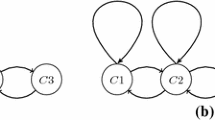Abstract
In this paper we investigate the operations of insertion and deletion performed at the ends of a string. We show that using these operations in a P systems framework (which corresponds to using specific variants of graph control), computational completeness can even be achieved with the operations of left and right insertion and deletion of only one symbol, both in the generating as well as in the accepting case.
Similar content being viewed by others
References
Alhazov A, Krassovitskiy A, Rogozhin Yu, Verlan S (2011a) P systems with minimal insertion and deletion. Theor Comput Sci 412(1–2):136–144
Alhazov A, Krassovitskiy A, Rogozhin Yu, Verlan S (2011b) P systems with insertion and deletion exo-operations. Fundam Inform 110(1–4):13–28
Alhazov A, Krassovitskiy A, Rogozhin Yu (2012) Circular post machines and P systems with exo-insertion and deletion. In: Gheorghe M et al (eds) Membrane computing—12th international conference, CMC 2011, Fontainebleau, France, August 23–26, 2011, revised selected papers. Lecture notes in computer science 7184. Springer, New York, pp 73–86
Benne R (1993) RNA editing: the alteration of protein coding sequences of RNA. Ellis Horwood, Chichester
Biegler F, Burrell MJ, Daley M (2007) Regulated RNA rewriting: modelling RNA editing with guided insertion. Theor Comput Sci 387(2):103–112
Castellanos J, Martín-Vide C, Mitrana V, Sempere JM (2001) Solving NP-complete problems with networks of evolutionary processors. In: Mira J, Prieto AG (eds) IWANN 2001. Lecture notes in computer science 2084. Springer, New York, pp 621–628
Csuhaj-Varjú E, Salomaa A (1997) Networks of parallel language processors. In: Păun Gh, Salomaa A (eds) New trends in formal languages. Lecture notes in computer science 1218. Springer, New York, pp 299–318
Dassow J, Manea F (2010) Accepting hybrid networks of evolutionary processors with special topologies and small communication. In: McQuillan I, Pighizzini G (eds) Proceedings of the 12th workshop on descriptional complexity of formal systems, EPTCS 31, pp 68–77
Dassow J, Păun Gh (1989) Regulated rewriting in formal language theory. Springer, New York
Dassow J, Manea F, Truthe B (2011) On normal forms for networks of evolutionary processors. In: Calude CS, Kari J, Petre I, Rozenberg G (eds) Proceedings of the unconventional computation 10th international conference, UC 2011, Turku, Finland, June 6–10, 2011. Lecture notes in computer science 6714, pp 89–100
Freund R, Oswald M, Păun A (2004) Gemmating P systems are computationally complete with four membranes. In: Ilie L, Wotschke D (eds) Pre-proceedings DCFS 2004. The University of Western Ontario, Rep. No. 619, pp 191–203
Freund R, Kogler M, Rogozhin Yu, Verlan S (2010) Graph-controlled insertion–deletion systems. In: McQuillan I, Pighizzini G (eds) Proceedings of the 12th workshop on descriptional complexity of formal systems, EPTCS 31, pp 88–98
Freund R, Rogozhin Yu, Verlan S (2012) P systems with minimal left and right insertion and deletion. In: Durand-Lose J, Jonoska N (eds) Unconventional computation and natural computation, 11th international conference, UCNC 2012, Orleans, France, September 3–7, 2012. Lecture notes in computer science 7445. Springer, New York, pp 82–93
Galiukschov B (1981) Semicontextual grammars. Logica i Matem. Lingvistika. Tallin University, pp 38–50 (in Russian)
Haussler D (1982) Insertion and iterated insertion as operations on formal languages. PhD thesis, University of Colorado at Boulder, Boulder
Haussler D (1983) Insertion languages. Inf Sci 31(1):77–89
Ivanov S, Verlan S (2011) Random context and semi-conditional insertion–deletion systems. arXiv, CoRR abs/1112.5947
Kari L (1991) On insertion and deletion in formal languages. PhD thesis, University of Turku, Turku
Kari L, Păun Gh, Thierrin G, Yu S (1997) At the crossroads of DNA computing and formal languages: characterizing RE using insertion–deletion systems. In: Rubin H, Wood DH (eds) DNA based computers III. Proceedings of the 3rd DIMACS workshop on DNA based computing, University of Pennsylvania, Philadelphia. DIMACS series in discrete mathematics and theoretical computer science 48, pp 318–333
Krassovitskiy A, Rogozhin Yu, Verlan S (2011) Computational power of insertion–deletion (P) systems with rules of size two. Nat Comput 10(2):835–852
Marcus S (1969) Contextual grammars. Rev Roum Math Pures Appl 14:1525–1534
Margenstern M, Mitrana V, Pérez-Jiménez M (2005a) Accepting hybrid networks of evolutionary systems. In: Ferretti C, Mauri G, Zandron C (eds) DNA computing: 10th international workshop on DNA computing, DNA10, Milan, Italy, June 7–10, 2004. Revised selected papers. Lecture notes in computer science 3384. Springer, New York, pp 235–246
Margenstern M, Păun Gh, Rogozhin Yu, Verlan S (2005b) Context-free insertion–deletion systems. Theor Comput Sci 330(2):339–348
Minsky ML (1967) Computation: finite and infinite machines. Prentice Hall, Englewood Cliffs
Păun Gh (2002) Membrane computing. An introduction. Springer, New York
Păun Gh, Rozenberg G, Salomaa A (eds) (1998) DNA computing: new computing paradigms. Springer, New York
Păun Gh, Rozenberg G, Salomaa A (2010) The Oxford handbook of membrane computing. Oxford University Press, Oxford
Petre I, Verlan S (2010) Matrix insertion–deletion systems. arXiv, CoRR abs/1012.5248
Post EL (1943) Formal reductions of the general combinatorial decision problem. Am J Math 65(2):197–215
Rozenberg G, Salomaa A (1997) Handbook of formal languages, 3 vols. Springer, New York
Verlan S (2007) On minimal context-free insertion–deletion systems. J Autom Lang Comb 12(1–2):317–328
Verlan S (2010a) Recent developments on insertion–deletion systems. Comput Sci J Moldova 18(2):210–245
Verlan S (2010b) Study of language-theoretic computational paradigms inspired by biology. Habilitation thesis, University of Paris Est, Paris
Author information
Authors and Affiliations
Corresponding author
Rights and permissions
About this article
Cite this article
Freund, R., Rogozhin, Y. & Verlan, S. Generating and accepting P systems with minimal left and right insertion and deletion. Nat Comput 13, 257–268 (2014). https://doi.org/10.1007/s11047-013-9396-3
Published:
Issue Date:
DOI: https://doi.org/10.1007/s11047-013-9396-3




